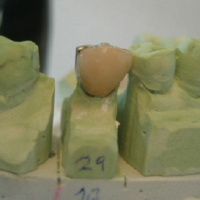
Single crowns or routine fillings for the restoration of root-filled teeth
Root filling is a fairly routine dental procedure in which the injured or dead nerve of a tooth is removed and replaced by a root canal filling. However, the restoration of root-filled teeth can be quite challenging as these teeth tend to be weaker than healthy ones. A dentist may use crowns (restorations made outside of the mouth and then cemented into place) or conventional fillings (direct filling with materials such as amalgam or composite/plastic resin). Although crowns may help to protect root-filled teeth by covering them, conventional fillings demand less in terms of time, costs and removal of tooth structure.
What was the research?
A systematic review of the evidence to find out whether there is a difference in the effects of restoration of root-filled teeth (with or without post and core) by indirect restorations (commonly crowns, inlays, or onlays) compared to conventional filling materials placed directly into the tooth.
Who conducted the research?
The research was conducted by a team led by Patrick Sequeira-Byron from the University of Bern on behalf of the Cochrane Oral Health Group. Zbys Fedorowicz, Ben Carter, Mona Nasser and Eman F Alrowaili were also on the team.
What evidence was included in the review?
Only one randomised controlled trial meeting the inclusion criteria was found. A total of 117 people participated in the trial, and were randomly assigned to receive either a fused porcelain to metal crown or a white dental filling.
What did the evidence say?
The evidence produced from one study concluded that none of the 117 root-filled premolars experienced a catastrophic failure (i.e. one that cannot be repaired) after three years, although only 104 teeth were included in the final, three-year assessment. The study concluded there was no difference between treatments for the risk of non-catastrophic failure. There was no evidence available for any of our secondary outcomes: patient satisfaction and quality of life, incidence or recurrence of decay, periodontal health status, and costs.
How good was the evidence?
The quality of the evidence is very low. As there is only a single study, which is at high risk of bias, there is insufficient reliable evidence to determine whether single crowns are better than routine fillings.
What are the implications for dentists and the general public?
There is insufficient reliable evidence from this review to determine whether a conventional filling, such as composite material, is more effective than full coronal coverage for the restoration of root-filled premolar teeth with sufficient coronal tooth structure. More high quality studies are needed.
What should researchers look at in the future?
Future research should aim to provide more reliable information that can help clinicians to decide on appropriate treatment whilst taking into consideration the individual circumstances and preferences of their patients.
Read the full-text review on the Cochrane Library
